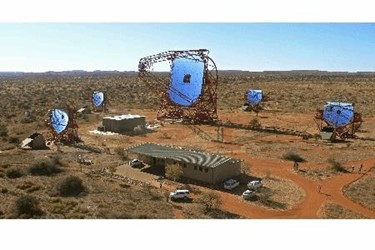The Start Of Multi-Messenger Astronomy

Worldwide network of telescopes observes source of gravitational waves for the first time
Shortly after the announcement of the Nobel Prize in Physics 2017 for the US researchers Rainer Weiss, Barry Barish and Kip Thorne for the first direct detection of gravitational waves, scientists report the next breakthrough in the young field: The observatories LIGO in the USA and VIRGO in Italy have registered gravitational waves of a merging pair of neutron stars for the first time. In an unprecedented worldwide observational campaign, in which DESY scientists participated among many other researchers, the counterpart was found. The object was identified to be a so-called Kilonova, a star that became very bright for a few days, which could be detected in visible light as well as in the infrared and X-ray wavelength range. “The observations are paving the way for a new era of multi-messenger astronomy, the investigation of cosmic objects with multiple cosmic messengers,” says Marek Kowalski, who is a leading scientist at DESY and was one of the 3600 researchers from more than 900 institutes worldwide who participated in the observation campaign. DESY scientists also participated in searches with the international gamma-ray observatory H.E.S.S. and the neutrino telescope IceCube.
Gravitational waves are emitted when massive objects such as black holes or neutron stars rotate around each other and finally merge with each other. LIGO and VIRGO recorded gravitational waves with the characteristic signature of merging neutron stars on 17 August 2017. Only two seconds after this event, NASA's gamma-ray satellite Fermi registered a short gamma-ray burst from the same direction in a distant galaxy. This coincidence proves the decades-long assumption that short gamma-ray bursts are caused by the fusion of neutron stars.
Subsequently, numerous telescopes searched for the event in all wavelength ranges. First, the Carnegie institution's Swope telescope in Chile was able to pinpoint the source more precisely. The following observations also include studies of the ePESSTO programme with the New Technology Telescope (NTT) of the European Southern Observatory ESO, which showed that the object was a kilonova. Traces of the chemical elements caesium and tellurium could be detected in the radiation spectrum of this kilonova, as the researchers report in the British journal "Nature", which publishes a series of scientific studies on the gravitational wave event.
The origin of such intermediate-mass chemical elements had long been a source for speculation. While lighter elements up to iron are produced by nuclear fusion in stars and heavy elements in supernova explosions, researchers have for some time suspected that merging neutron stars can produce intermediate mass elements. This assumption is supported by the ePESSTO observations. “That the first observation of a neutron star merger confirms the model expectations so well, while simultaneously pointing to the origin of intermediate-mass chemical elements is a breathtaking development,” says Kowalski, who is a member of ePESSTO.
The gamma-ray observatory H.E.S.S. (High Energy Stereoscopic System) in Namibia, in which DESY is involved, was the first ground-based telescope system to point to the direction of the gravitational waves. For almost a week, Iryna Lypova and Eva Leser, PhD students at DESY and the University of Potsdam, observed the sky region in question with H.E.S.S. “Although the source could not be detected in the gamma range, our observations allow for the first time a statement about the maximum possible emission of high-energy radiation during the fusion of two neutron stars,” explains Leser.
The International Neutrino Observatory IceCube at the South Pole has also been searching for evidence in almost real time. The system was implemented by scientists at DESY, the largest IceCube partner in Europe. Neutrinos allow investigations in energy areas beyond those accessible by electromagnetic radiation and can detect extreme cosmic particle accelerators. In 2013, IceCube discovered the first high-energy cosmic neutrinos. The origin of IceCube’s neutrinos, which include kilonovae as a possible source class, remains unknown. In connection with the gravitational wave event IceCube did not detect a neutrino signal this time. But this might change on the next occasion.
Stefan Ohm, head of the H.E.S.S. Group at DESY, is also looking forward to the future: “The future observatory for gamma astronomy, the Cherenkov Telescope Array CTA, will provide a significant sensitivity increase. We are thus on the threshold to a new era in which we will gain many new insights into our universe through the interplay of different telescopes.”
Source: Deutsches Elektronen-Synchrotron
